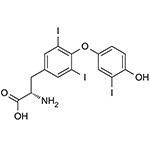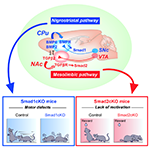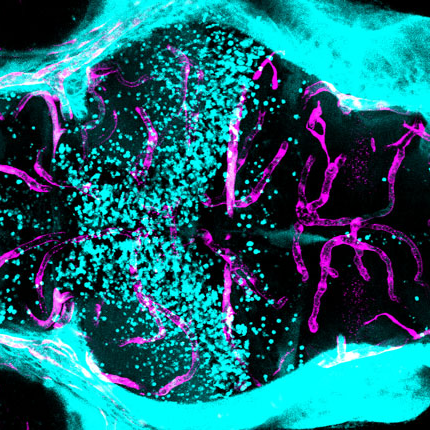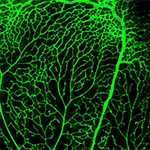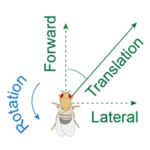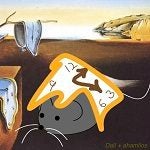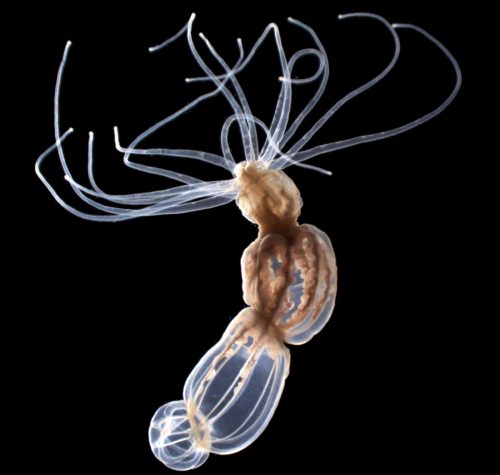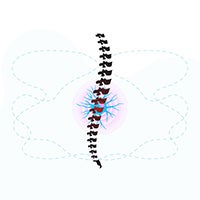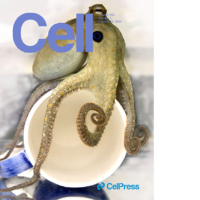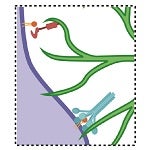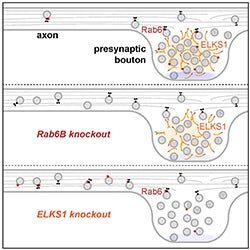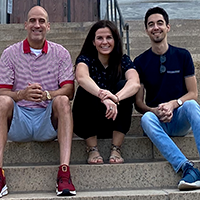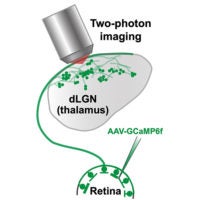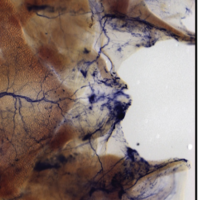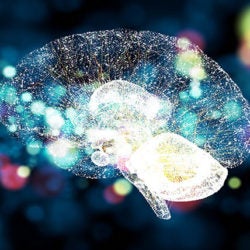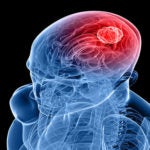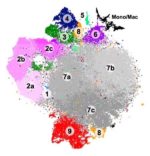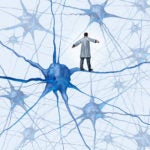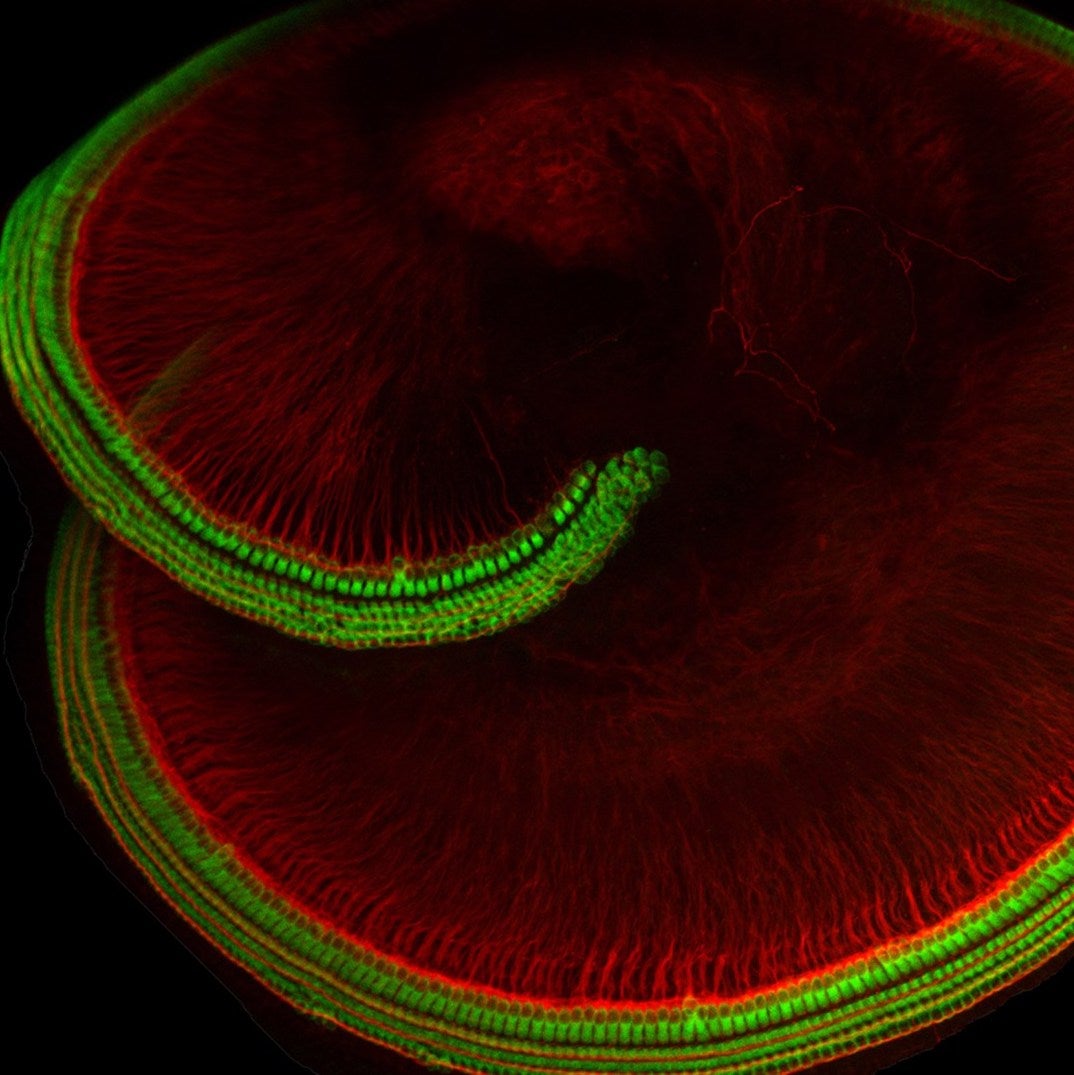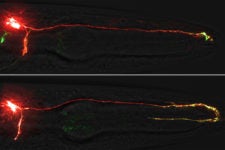Neuro Topics - Cell Signaling
SEARCH OTHER RESEARCH AREAS
March 8, 2024
Thyroid signaling plays a central role in metabolism. Ralph Lawton and Daniel Hochbaum of the Sabatini Lab share new research revealing it may regulate human behavior and other important components of health as well.
Original article in: PNAS >
October 6, 2023
Akiko Terauchi and Hisashi Umemori share new research that identified the pathway-specific signals that establish functionally segregated dopaminergic synaptic connections in the mammalian brain. The findings may provide strategies to treat pathway-specific disease symptoms in diseases like Parkinson's disease, schizophrenia, and depression, by targeting the pathway-specific molecular signals.
Original article in: Cell >
July 21, 2023
HMS News article on new research from Sean Megason, Chenghua Gu, Allon M. Klein, and colleagues, first author Natasha O'Brown, using mice and zebrafish to discover a signal produced by neurons that helps the blood-brain barrier form and maintain its protective properties.
Original article in: Developmental Cell >
June 15, 2022
Harvard Dept. of MCB News article on new research from Catherine Dulac and colleagues, first author Jessica Osterhout, showing how neurons in the brain directly read signals from the body’s immune system and how those signals alter neural circuit activity to trigger symptoms of sickness.
Original article in: Nature >
May 24, 2022
HMS News profile on Josefina del Marmol, a newly hired assistant professor of biological chemistry and molecular pharmacology, who studies how animals detect and identify scents.
Original article in: Nature >
May 24, 2022
Harvard Health Publishing article outlining LATE (limbic-predominant age-related TDP-43 encephalopathy), the third most common cause of dementia in older individuals.
Original article in: Nature >
April 21, 2022
HMS News article on new research from the lab of Chenghua Gu, first author Swathi Ayloo, identifying a new mechanism regulating the permeability of the blood-brain barrier in mice.
Original article in: Neuron >
March 9, 2022
Jenny Lu and colleagues in Rachel Wilson’s lab share new work on a neural circuit in the fly that transforms velocity from body-centric to world-centric reference frames. This work reveals how vector computations can be performed in the brain.
Original article in: Neuron >
February 25, 2022
Allison E. Hamilos from the lab of John Assad shares new insights into the role of dopaminergic signaling in modulating the moment-to-moment probability of planned movement.
Original article in: eLife >
February 24, 2022
Harvard Gazette article on a recent panel sponsored by the Harvard Mind Brain Behavior Initiative featuring Kirk R. Daffner, Daniel L. Schacter, and Susanna C. Siegel using the plot of the film Memento to discuss memory, amnesia, and personality.
Original article in: eLife >
February 26, 2021
Harvard Gazette article on research probing the molecular basis for the stinging response in sea anemones and jellyfish, and identifying how these organisms detect and filter cues from the environment when making the decision to sting or not sting. From the labs of Nicholas Bellono, Amy Lee and colleagues, first author Keiko Weir.
Original article in: eLife >
November 30, 2020
BCH Discoveries article on new research from the lab of Zhigang He, joint first authors Yi Li, Xuelian He, and Riki Kawaguchi. They studied recovery from spinal cord injury in neonatal mice and found that microglia cells play a crucial role in the healing process.
Original article in: Nature >
November 2, 2020
MCB News piece on new research from the Bellono lab, first author Lena van Giesen, uncovering the molecular basis of chemotactile sensation in octopuses.
Original article in: Cell >
October 19, 2020
Chris Chen of Wade Regehr's lab shares new research on ephaptic coupling--a unique form of neuronal communication that is not mediated by chemicals or physical connections--in the cerebellum.
Original article in: Nature Neuroscience >
October 5, 2020
Nicole Scott-Hewitt shares new research from the labs of Beth Stevens and colleagues, providing mechanistic insight into how microglia mediate developmental synapse pruning.
Original article in: EMBO >
October 2, 2020
Hajnalka “Sunny” Nyitrai shares new research from the lab of Pascal Kaeser addressing how neurons transport material to the synapse and how they ensure delivery to the appropriate destinations.
Original article in: Cell Reports >
October 1, 2020
Michael Do shares new findings from his lab on the question of why humans and other primates see more sharply than other mammals.
Original article in: Neuron >
September 29, 2020
Caroline Palavicino-Maggio writes about the Journal of Emerging Investigators Mini PhD Camp, a unique program introducing underserved middle and high school students to the sciences, how to conduct research, and how to write scientific papers.
Original article in: Neuron >
September 14, 2020
Liang Liang, Mark Andermann and Chinfei Chen discuss new findings suggesting that the modulation of visual responses to certain stimuli can occur at very early stages of visual processing, when visual signals first enter the brain.
Original article in: Neuron >
August 10, 2020
Aditi Banerjee shares new research from the lab of Pascal Kaeser demonstrating that Synaptotagmin-1 acts as the fast calcium sensor to support dopamine release.
Original article in: eLife >
May 27, 2020
A new study from Keiko Weir and colleagues in lab of Nicholas Bellono, addresses the question of how single nematocytes detect and filter diverse cues from their environment to control when (and when not) to sting.
Original article in: eLife >
May 6, 2020
HMS News article on new research from the lab of Stephen Liberles, co-first authors Sara Prescott and Benjamin Umans, identifying rare throat-innervating sensory neurons that guard upper airways against threats.
Original article in: Cell >
March 4, 2020
HMS News article on new research from the labs of Chenghua Gu and Bernardo Sabatini, first authors Brian Chow and Vicente Nunez, revealing how the brain and arteries communicate to increase blood flow for neural activity.
Original article in: Nature >
February 3, 2020
BIDMC News article on new research from the lab of Mark Andermann (first author Yoav Livneh) shedding new light on interoception.
Original article in: Neuron >
December 19, 2019
HMS News article on new research from the lab of Zheng Yi-Chen, joint first authors Yilai Shu, Wenyan Li, Mingqian Huang, and Yi-Zhou Quan, introducing a new strategy to reprogram and regenerate inner-ear cells.
Original article in: Nature Communications >
November 27, 2019
HMS News article on new research from the labs of Bernardo Sabatini and colleagues on the development of a new light-based method to capture and pinpoint the epicenter of neural activity in the brain.
Original article in: Nature Methods >
March 6, 2019
Insulin signaling failures in the brain linked to Alzheimer’s disease.
Original article in: PNAS >
January 31, 2019
This paper explores what NK cells do in response to nerve injury and how understanding that could lead to better treatments for pain.
Original article in: PNAS >
January 30, 2019
HMS News article, on new research from the team of PierPaolo Peruzzi, E. Antonio Chiocca, and colleagues (first author Vivek Bhaskaran), showing how certain microRNAs can weaken brain cancer cells in advance of standard therapy in preclinical models.
Original article in: Nature Communications >
December 20, 2018
Along with along with Larry Zipursky, Josh Sanes has been awarded the 2018 Perl-UNC Neuroscience Prize for the “discovery of cell-surface proteins that control circuit assembly in the visual system.”
Original article in: Nature Communications >
December 20, 2018
Isaac Chiu and Debora Marks were awarded Ben Barres Early Career Acceleration Awards. David Walt and George Church were awarded a Collaborative Science Award by the Chan Zuckerberg Initiative.
Original article in: Nature Communications >
December 20, 2018
HMS News article on new research from the lab of Qiufu Ma identifying the nerve pathway that drives sustained pain following injury.
Original article in: Nature >
December 11, 2018
In the glimpse of the past provided by organoids, Paola Arlotta sees a chance to shape the future of how we fight neurological disease
Original article in: Nature >
December 3, 2018
Congratulations to Carl Nist-Lund, Bifeng Pan, Jeffrey Abbott, Tianyang Ye, Swathi Ayloo, Brian Wai Chow, and Kevin Sitek. Each winner will receive $200 and a customized desk plaque with their image.
Original article in: Nature >
December 1, 2018
HMS News article on new research from the labs of Beth Stevens and Steven McCarroll on identifying which microglia in the brain are "good" and which are "bad".
Original article in: Nature >
November 21, 2018
They were recognized for scientifically and socially distinguished work
Original article in: Nature >
November 5, 2018
HMS News article on an announcement by the Bertarelli Foundation and HMS of four new collaborative research grants given to Harvard neuroscientists tackling sensory disorders--from hearing loss, deafness and blindness to acute and chronic pain.
Original article in: Nature >
October 10, 2018
BCH Vector Blog post on new research from the labs of Beth Stevens, Chinfei Chen, Hisashi Umemori and colleagues, identifying a “don’t eat me” signal which prevents microglia from pruning away useful synaptic connections
Original article in: Neuron >
September 12, 2018
HMS News article highlighting a new study from the labs of Zhigang He, Clifford Woolf and colleagues identifying neurons in the brain that influence touch sensitivity.
Original article in: Nature >
August 27, 2018
Harvard Gazette story on new work from the labs of Jeffrey Holt, David Corey and colleagues, revealing identity of a sensor protein that helps inner ear hair cells translate sound and head movements into electrical signals that the brain can process
Original article in: Neuron >
August 24, 2018
HMS News article on a recent study from the lab of Maxwell Heiman suggesting that neuron length must be actively maintained throughout life.
Original article in: PLoS Genetics >
August 21, 2018
Ana Pereira and Yun Zhang describe a new project that was recently awarded funding from the Dean's Competitive Fund for Promising Scholarship
Original article in: PLoS Genetics >
July 17, 2018
An eLife press release on new work from the labs of Yun Zhang and Joshua Kaplan, exploring how C. elegans sense and avoid nitric oxide in their environments
Original article in: eLife >

